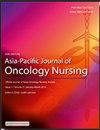Decomposition analysis of lung cancer and COPD mortality attributable to ambient PM2.5 in China (1990–2021)
IF 2.4
3区 医学
Q1 NURSING
引用次数: 0
Abstract
Objective
This study aimed to evaluate the long-term trends in lung cancer (LC) and chronic obstructive pulmonary disease (COPD) mortality attributable to particulate matter (PM2.5) in China and to identify the contributions of population aging and other risk factors to changes in mortality rates.
Methods
Using data from 1991 to 2021, we assessed trends in LC and COPD deaths attributable to PM2.5 through linear regression. Decomposition analysis was conducted to determine the extent to which changes in mortality rates were driven by demographic and non-demographic factors.
Results
The crude mortality rates attributable to PM2.5 increased significantly for LC (500.40%) and COPD (85.26%). From 1990 to 2021, LC mortality attributable to PM2.5 increased annually by 4.11% (95% CI: 3.64%, 4.59%), while COPD mortality decreased annually by 1.23% (95% CI: −0.82%, −1.65%). Decomposition analysis revealed that 43.0% of the increase in LC mortality was due to population aging, and 57.0% was attributed to changes in other risk factors. For COPD, population aging contributed to an 18.547/100,000 increase, whereas other risk factors reduced mortality by 10.628/100,000.
Conclusions
The findings highlight the critical roles of population aging and risk factor modification in LC and COPD mortality trends. Interventions to address aging-related vulnerabilities and air pollution control are essential to mitigate future health burdens.
1990-2021年中国环境PM2.5导致肺癌和COPD死亡率的分解分析
目的评价中国PM2.5致肺癌(LC)和慢性阻塞性肺疾病(COPD)死亡率的长期趋势,并探讨人口老龄化等危险因素对死亡率变化的影响。方法使用1991年至2021年的数据,我们通过线性回归评估PM2.5导致的LC和COPD死亡趋势。进行了分解分析,以确定死亡率变化在多大程度上受人口和非人口因素的影响。结果PM2.5导致的粗死亡率在LC(500.40%)和COPD(85.26%)中显著升高。从1990年到2021年,PM2.5导致的LC死亡率每年增加4.11% (95% CI: 3.64%, 4.59%),而COPD死亡率每年下降1.23% (95% CI: - 0.82%, - 1.65%)。分解分析显示,LC死亡率增加的43.0%归因于人口老龄化,57.0%归因于其他危险因素的变化。对于慢性阻塞性肺病,人口老龄化导致死亡率增加18.547/10万,而其他危险因素使死亡率降低10.628/10万。结论该研究结果强调了人口老龄化和危险因素改变在慢性阻塞性肺病和慢性阻塞性肺病死亡率趋势中的关键作用。解决与老龄化有关的脆弱性和控制空气污染的干预措施对于减轻未来的健康负担至关重要。
本文章由计算机程序翻译,如有差异,请以英文原文为准。
求助全文
约1分钟内获得全文
求助全文
来源期刊

Asia-Pacific Journal of Oncology Nursing
Multiple-
CiteScore
2.80
自引率
11.10%
发文量
136
审稿时长
31 days
 求助内容:
求助内容: 应助结果提醒方式:
应助结果提醒方式:


